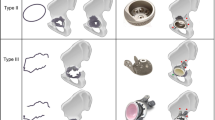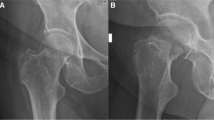Abstract
Purpose
The purposes of the study were to introduce surgical technique of fragment-specific fixation technique using multiple 2.7-mm variable-angle locking compression plates (VA LCPs) in comminuted posterior wall acetabular fractures and reported its clinical results.
Patients and methods
Among the 68 patients, 23 with comminuted posterior wall factures with ≥ 3 fragments in the CT scan and no column involvement with a minimum follow-up duration of 12 months were enrolled in this study. We evaluated the clinical results after the treatment of comminuted posterior wall acetabular fractures via the fragment-specific fixation technique using 2.7-mm variable-angle locking compression plates (VA LCPs) retrospectively.
Results
The average duration of follow-up was 26.8 months. Anatomical reduction was achieved in eighteen patients. Imperfect reduction was achieved in five patients. 22 patients achieved fracture union and one patient underwent revision surgery owing to acute postoperative infection. There were no complications, including loss of reduction, fixative failures, sciatic nerve palsy, heterotopic ossification, and early posttraumatic arthritis among 22 patients. The average functional outcome was measured as ‘very good’.
Conclusion
Fragment-specific fixation technique using 2.7-mm VA LCPs for comminuted posterior wall acetabular fractures could be an acceptable alternative means of surgical fixation.






Similar content being viewed by others
References
Baumgaertner MR (1999) Fractures of the posterior wall of the acetabulum. JAAOS J Am Acad Orthop Surg 7(1):54–65
Letournel E, Judet R (2012) Fractures of the acetabulum. Springer, New York
Olson SA, Finkemeier CG (1999) Posterior wall fractures. Oper Tech Orthop 9(3):148–160
Letournel E (2007) Acetabulum fractures: classification and management. Orthop Trauma Dir 5(05):27–33
Mears DC, Velyvis JH, Chang C-P (2003) Displaced acetabular fractures managed operatively: indicators of outcome. Clin Orthop Relat Res 407:173–186
Moed BR, Carr SEW, Watson JT (2000) Open reduction and internal fixation of posterior wall fractures of the acetabulum. Clin Orthop Relat Res 1976–2007(377):57–67
Firoozabadi R, Hamilton B, Toogood P, Shearer D (2018) Risk factors for conversion to Total hip arthroplasty after acetabular fractures involving the Posterior Wall. J Orthop Trauma 32(12):607–611
Verbeek DO, Van Der List JP, Tissue CM, Helfet DL (2018) Predictors for long-term hip survivorship following acetabular fracture surgery: importance of gap compared with step displacement. JBJS 100(11):922–929
Moed BR, Carr SEW, Watson JT (2002) Results of operative treatment of fractures of the posterior wall of the acetabulum. JBJS 84(5):752–758
Saterbak AM, Marsh JL, Nepola JV, Brandser EA, Turbett T (2000) Clinical failure after posterior wall acetabular fractures: the influence of initial fracture patterns. J Orthop Trauma 14(4):230–237
Askam B, Sims S (2019) Supplemental superior buttress plating for the treatment of posterosuperior wall acetabulum fractures. J Orthop Trauma 33:S27–S31
Richter H, Hutson JJ, Zych G (2004) The use of spring plates in the internal fixation of acetabular fractures. J Orthop Trauma 18(3):179–181
Ebraheim NA, Patil V, Liu J, Sanford CG, Haman SP (2007) Reconstruction of comminuted posterior wall fractures using the buttress technique: a review of 32 fractures. Int Orthop 31(5):671–675
Giannoudis P, Tzioupis C, Moed B (2007) Two-level reconstruction of comminuted posterior-wall fractures of the acetabulum. J Bone Jt Surg Br 89(4):503–509
Lee C, Johnson EE (2018) Use of spring plates in fixation of comminuted posterior wall acetabular fractures. J Orthop Trauma 32:S55–S59
Verbeek DO, van der List JP, Helfet DL (2019) Computed tomography versus plain radiography assessment of acetabular fracture reduction is more predictive for native hip survivorship. Arch Orthop Trauma Surg. https://doi.org/10.1007/s00402-019-03192-w
Moed BR, Carr SEW, Gruson KI, Watson JT, Craig JG (2003) Computed tomographic assessment of fractures of the posterior wall of the acetabulum after operative treatment. JBJS 85(3):512–522
Mohanty K, Taha W, Powell J (2004) Non-union of acetabular fractures. Injury 35(8):787–790
d'Aubigne RM, Postel M (1954) Functional results of hip arthroplasty with acrylic prosthesis. JBJS 36(3):451–475
Heare A, Kramer N, Salib C, Mauffrey C (2017) Early versus late weight-bearing protocols for surgically managed posterior wall acetabular fractures. Orthopedics 40(4):e652–e657
Matta JM (1996) Fractures of the acetabulum: accuracy of reduction and clinical results in patients managed operatively within three weeks after the injury. JBJS 78(11):1632–1645
Kreder H, Rozen N, Borkhoff C, Laflamme Y, McKee M, Schemitsch E, Stephen D (2006) Determinants of functional outcome after simple and complex acetabular fractures involving the posterior wall. J Bone Jt Surg Br 88(6):776–782
Rollmann MF, Holstein JH, Pohlemann T et al (2018) Predictors for secondary hip osteoarthritis after acetabular fractures—a pelvic registry study. Int Orthop. https://doi.org/10.1007/s00264-018-4169-3
Giannoudis P, Grotz M, Papakostidis C, Dinopoulos H (2005) Operative treatment of displaced fractures of the acetabulum: a meta-analysis. J Bone Jt Surg Br 87(1):2–9
Pascarella R, Cerbasi S, Politano R, Balato G, Fantasia R, Orabona G, Mariconda M (2017) Surgical results and factors influencing outcome in patients with posterior wall acetabular fracture. Injury 48(8):1819–1824
Borg T, Hailer NP (2015) Outcome 5 years after surgical treatment of acetabular fractures: a prospective clinical and radiographic follow-up of 101 patients. Arch Orthop Trauma Surg 135(2):227–233
Ziran BH, Little JE, Kinney RC (2011) The use of a T-plate as “spring plates” for small comminuted posterior wall fragments. J Orthop Trauma 25(9):574–576
Lee AK, Wagner BR, McPhillips K, Horwitz DS, Widmaier JC Jr (2017) locking compression pilon plate for fixation of comminuted posterior wall acetabular fractures: a novel technique. J Orthop Trauma 31(1):e32–e36
Schwab JM, Zebrack J, Schmeling GJ, Johnson J (2011) The use of cervical vertebrae plates for cortical substitution in posterior wall acetabular fractures. J Orthop Trauma 25(9):577–580
Goulet JA, Rouleau JP, Mason DJ, Goldstein SA (1994) Comminuted fractures of the posterior wall of the acetabulum. A biomechanical evaluation of fixation methods. JBJS 76(10):1457–1463
Giannoudis P, Nikolaou V (2008) Surgical techniques—How do I do it?: open reduction and internal fixation of posterior wall fractures of the acetabulum. Injury 39(10):1113–1118
Maini L, Verma T, Sharma A, Sharma A, Mishra A, Jha S (2018) Evaluation of accuracy of virtual surgical planning for patient-specific pre-contoured plate in acetabular fracture fixation. Arch Orthop Trauma Surg 138(4):495–504
Zeng C, Xing W, Wu Z, Huang H, Huang W (2016) A combination of three-dimensional printing and computer-assisted virtual surgical procedure for preoperative planning of acetabular fracture reduction. Injury 47(10):2223–2227
Chana-Rodríguez F, Mañanes RP, Rojo-Manaute J, Gil P, Martínez-Gómiz JM, Vaquero-Martín J (2016) 3D surgical printing and pre contoured plates for acetabular fractures. Injury 47(11):2507–2511
Tosounidis TH, Giannoudis PV (2017) Use of inlet-obturator oblique view (Leeds View) for placement of posterior wall screws in acetabular fracture surgery. J Orthop Trauma 31(4):e133–e136
Funding
This work was supported by the Technology Innovation Progrma (10077279) funded by the Ministry of Trade, Industry & Energy (MOTIE, Korea).
Author information
Authors and Affiliations
Corresponding authors
Ethics declarations
Conflict of interest
The authors declare that they have no conflict of interest.
Ethical approval
All procedures performed in studies involving human participants were in accordance with the ethical standards of the institution or practice at which the studies were conducted.
Informed consent
Informed consent was obtained from all individual participants included in the study.
Rights and permissions
About this article
Cite this article
Cho, JW., Chung, H.J., Kim, BS. et al. Fragment specific fixation technique using 2.7 mm VA LCP for comminuted posterior wall acetabular fractures: a novel surgical technique. Arch Orthop Trauma Surg 139, 1587–1597 (2019). https://doi.org/10.1007/s00402-019-03236-1
Received:
Published:
Issue Date:
DOI: https://doi.org/10.1007/s00402-019-03236-1




